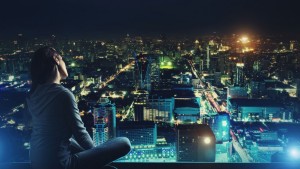 Turning off lights and drawing the shades when you go to sleep could help your body control weight gain, according to a study from Israel newly published in the International Journal of Obesity.
Turning off lights and drawing the shades when you go to sleep could help your body control weight gain, according to a study from Israel newly published in the International Journal of Obesity.
The study also affirmed past research showing a link between artificial light at night (ALAN) – especially from white LED bulbs — and some types of cancer.
“In recent years there are a lot of studies that use ALAN as a proxy for different health issues including obesity. Some lab studies have examined how ALAN leads to body-mass gain among mice,” explains University of Haifa mathematics and economics PhD student Nataliya Rybnikova.
“Researchers think this is because light suppresses the production of melatonin, a hormone produced by animals and humans mainly at night,” she tells ISRAEL21c. “Melatonin is responsible for metabolic function, and ALAN also influences metabolic function in people. So we decided to check if there is an association between ALAN and body-mass gain.”
Rybnikova worked on the study under the supervision of University of Haifa professors Boris Portnov and Abraham Haim, co-authors of the 2013 book Light Pollution as a New Risk Factor for Breast and Prostate Cancers.
Using publicly available images of artificial light emitted from the ground at night — captured by satellites in the US Defense Meteorological Satellite Program — Rybnikova mapped the levels by country and then compared that with country-specific data on obesity from the World Health Organization. Altogether she looked at data from more than 80 countries.
Even after adjusting for other variables known to influence obesity — such as the country’s average birthrate, dietary patterns, gross domestic product and percentage of urban population — ALAN still emerged as significant positive predictor for obesity, she reports.
Turn out the lights
“Many researchers are starting to understand that artificial light is not always a good thing. They are advising to switch off the lights, put down the curtains, and move electronic devices away from you and your children when going to sleep at night,” says Rybnikova, who just received a prestigious three-year Ilan Ramon Foundation Scholarship.
The study authors note that worldwide, overweight and obesity rates are on the rise. According to the World Health Organization, about 1,900 million adults are now defined as overweight (body mass index of 25 to 29.9) and about 600 million adults defined as obese (body mass index of 30 or higher).
“Increasing exposure to artificial light at night may influence body mass, by suppression of melatonin production and disruption of daily rhythms, resulting in physiological or behavioral changes in the human body, and may thus become a driving force behind worldwide overweight and obesity pandemic,” they write in a summary of their research, which is the first to confirm results of laboratory studies on ALAN’s contribution to excessive body mass in humans.
“This represents the first time that anyone has shown an association between obesity and light pollution on such a large scale,” Portnov told Haaretz.
Regarding breast and prostate cancer, the issue is that when white light suppresses melatonin, the body loses out on melatonin’s anti-oxidant and anti-cancer properties. Based on his studies, Haim promotes limiting the use of artificial white light at night and using only the amount of light needed for a task or safety.
Local studies done in Israel have indicated that higher levels of artificial lighting in a neighborhood correlate with a higher frequency of breast cancer and prostate cancer in that neighborhood.
Rybnikova hopes to use her Ilan Ramon scholarship to continue analyzing light signatures from satellite photographs and convert the data into actionable local and international information.


